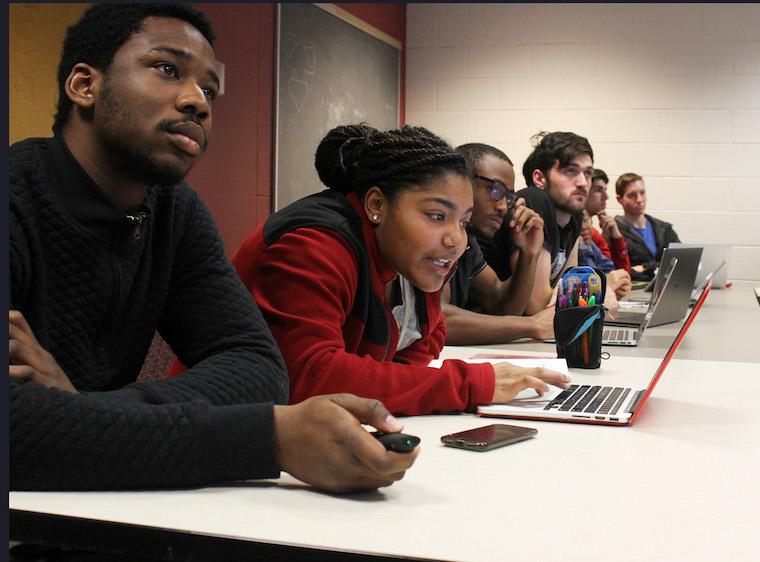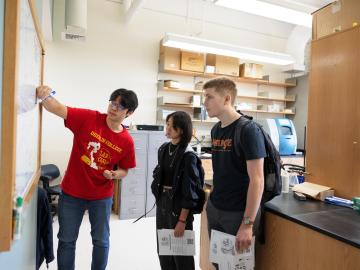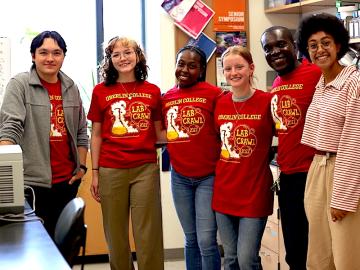Experience with Bloomberg Boosts Marketability
November 14, 2017
Amanda Nagy

In the year since Oberlin acquired a subscription to Bloomberg Analytics, economics students have been receiving valuable exposure to a platform that they will use in internships and in their careers.
“Bloomberg is the premier source of information for financial markets,” says Visiting Professor of Economics Ed McKelvey,’68, who worked for Goldman Sachs, J.P. Morgan, and the Federal Reserve Board during his career as a financial markets economist.
“If you walk into any financial institution, whether it’s a big or small company, you’ll find these things all over. If someone wants to go into the business of financial markets, if you want to be a trader, a securities analyst, an economist working in this area for one of the financial institutions—as I was for many years—this is the system you will eventually need to know.”
McKelvey and Assistant Professor of Economics Chris Cotter are incorporating the Bloomberg terminals in their courses. Students can access the software on 12 computers, with the majority in the King Building and several available in Mudd Center library.
“I’ve tried to use it in almost every class I’ve taught since we started our subscription in December 2016,” McKelvey says. “I’ve taught a course every other year in financial derivatives, which are things like options, interest rate swaps, and insurance contracts, and there I used it mostly to demonstrate the kind of information you could access on some of the securities we were talking about. It was mainly a tool to direct students in projects they might do on their own. They all had a term paper to write, so some of them used Bloomberg in compiling information for their papers.”
In his intermediate macroeconomics course, McKelvey has assigned a paper predating the Bloomberg terminal in which students are expected to research and answer questions about an economic indicator. Now, McKelvey explains, students access the labor market data, starting with change in private payrolls, and all the variables that economists predict.
“I’m asking them to go into Bloomberg and see what the economists are saying. If it’s an indicator that’s just been published, then I want to see how they did—how did the number come out compared with the forecast going in? And what’s the story? If they missed, why did they miss? This is the way economists function. It gets students closer to the real data.”
For members of the Oberlin Student Finance and Investment Club, research that used to take hours now takes just minutes on the Bloomberg terminal.

“Previously, to access information on a company's earrings and other financial statements, we would have to dig through files on the SEC website or rely on free sources such as Yahoo! Finance,” says fourth-year John Pierce, cochair and lead portfolio manager of the Oberlin Student Finance and Investment Club.
“Having all this information at our fingertips allows us to do a deeper analysis. For example, we are now more easily able to run analyses on how a company's financial statistic compares to its peers, or analyze how a stock's historical trading behavior might influence its future performance. Additionally, Bloomberg allows us to download data into Excel, which allows the club to build models to better understand a firm's future performance. With our fund up 19.33 percent year-to-date, we have clearly benefited from this new resource.”
Pierce was fortunate to gain entry into Bloomberg with several finance internships. But for the typical Oberlin student, the campus terminals will be their first exposure. “This exposure is extremely valuable, as proficiency in using the Bloomberg terminal is now a skill that many employers in finance are looking for applicants to have,” Pierce says.
Students can also take advantage of a self-directed online course, Bloomberg Market Concepts, that is included in the subscription. The course takes approximately eight hours and includes modules associated with the economy, currencies, fixed-income securities, and stocks. Upon completion, students can upload their certificates and their resumes in the Bloomberg directory. McKelvey gives students the option to take the online course for a small percentage of their course grade.
“That is a tremendous benefit because there is a networking capability,” McKelvey says. “You can find out a lot about people, what their current and past positions are, and their education. And you can put your resume in front of someone who might actually be looking for someone.”
Tags:
You may also like…
From Oberlin College to Goldman Sachs
May 16, 2024
Anna Silverman ’22 has made a remarkable leap, from Oberlin to the investment banking firm Goldman Sachs.
Friday Afternoon with Lab Crawl
October 30, 2023
This year’s Lab Crawl drew what may be the largest crowd in the event’s illustrious history, with some 500 students and dozens of faculty taking part. Missed out on the excitement? It looked something like this.
Lab Crawl: It’s Not Just for Scientists
October 24, 2023
Oct. 27 open house highlights research across the sciences—and just about everywhere else.


